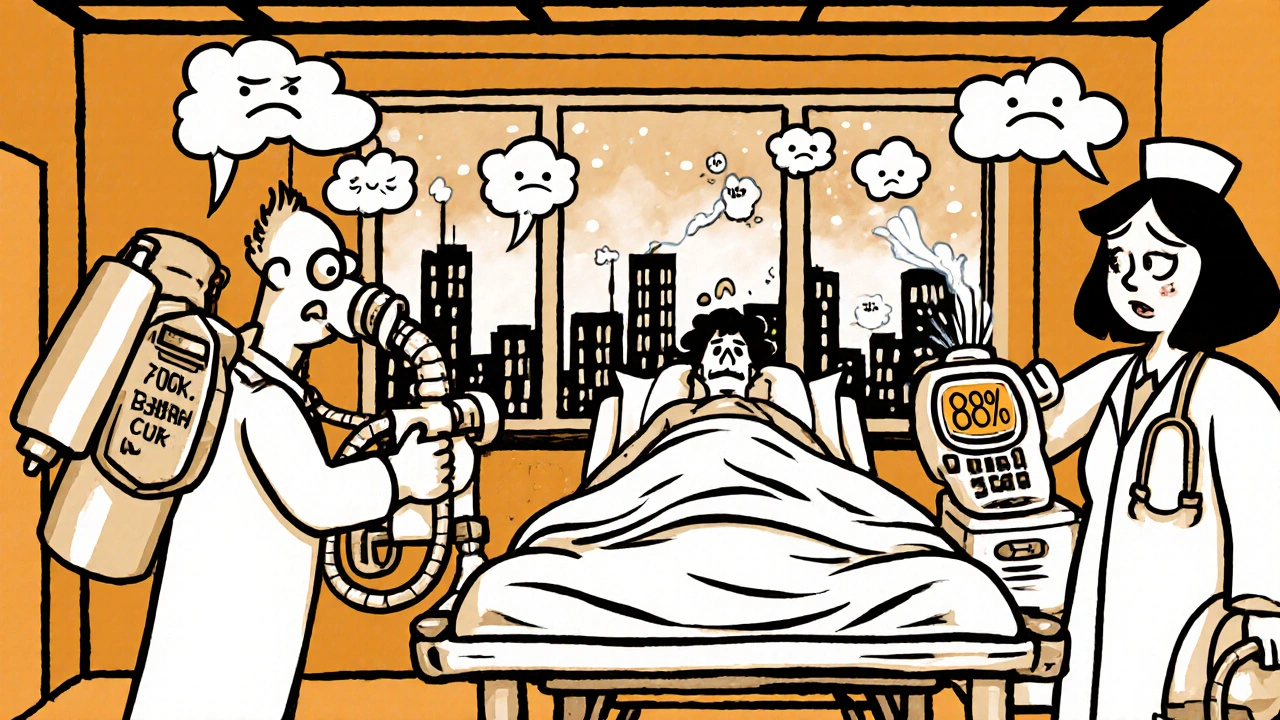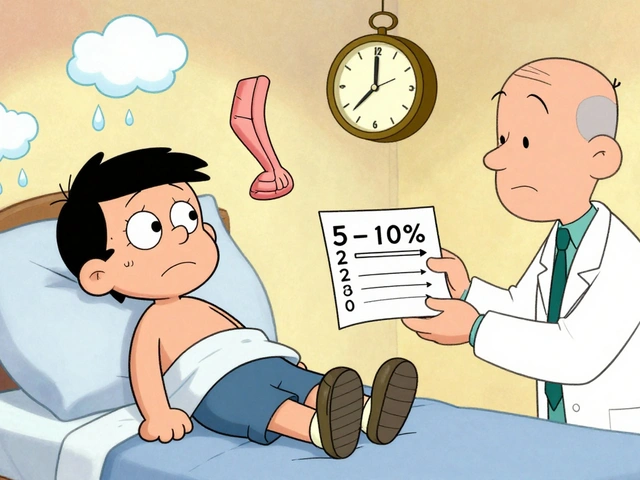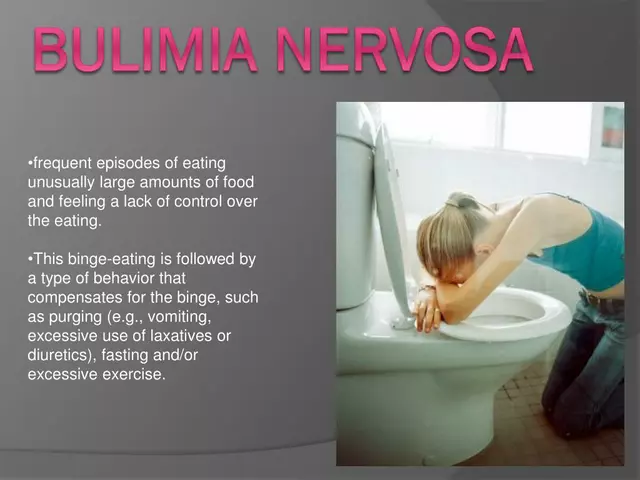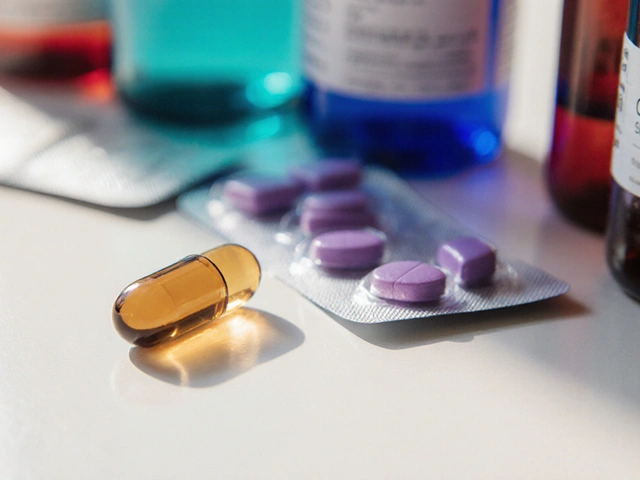What Exactly Is a COPD Exacerbation?
A COPD exacerbation isn’t just a bad day. It’s when your breathing suddenly gets much worse-so much that you can’t manage it with your usual meds. Your cough gets deeper, your chest feels heavier, and even walking to the kitchen leaves you gasping. This isn’t normal fluctuation. It’s a flare-up, often triggered by an infection or pollution, and it can land you in the hospital-or worse.
Most people with COPD have one or two of these flare-ups each year. But as the disease progresses, they happen more often. And each time, your lungs don’t fully recover. Permanent damage piles up. Studies show that even eight weeks after a flare-up, many patients still haven’t regained their pre-exacerbation lung function. That’s why treating these episodes fast isn’t optional-it’s life-saving.
What Are the Warning Signs?
You know your body better than anyone. But during a COPD exacerbation, it’s easy to mistake worsening symptoms for just being tired or having a cold. Here’s what to watch for:
- More coughing than usual, especially if it’s worse at night
- Changes in sputum-more of it, thicker, or a new color like yellow, green, or even streaked with blood
- Shortness of breath that’s worse than your baseline, even with minimal activity
- Wheezing or a tight feeling in your chest that doesn’t go away with your inhaler
- Fatigue so deep you can’t get out of bed
- Fever or chills-this often means infection is driving the flare-up
- Difficulty sleeping because you can’t catch your breath
If you notice two or more of these symptoms lasting more than two days, don’t wait. Call your doctor. If your lips or fingernails turn blue, you’re confused, or your oxygen levels drop below 88%, go to the ER immediately. Low oxygen isn’t just uncomfortable-it’s dangerous.
What Causes These Flare-Ups?
Three things cause about 75% of COPD exacerbations: infections, pollution, and irritants.
Infections are the biggest culprit. Viruses like the flu, colds, and RSV trigger about half of all flare-ups. Bacteria like Haemophilus influenzae, Streptococcus pneumoniae, and Moraxella catarrhalis cause another quarter. Even a mild cold can set off a chain reaction in your already inflamed airways-swelling, mucus buildup, and muscle spasms that make breathing feel like sucking air through a straw.
Environmental triggers are just as dangerous. Cold air, smoke (even secondhand), strong perfumes, cleaning fumes, and air pollution can all act like a match to dry tinder. In Birmingham, where winter fog and traffic fumes are common, many patients report worse flare-ups between November and February.
And yes, COVID-19 can cause COPD exacerbations. But here’s something surprising: research shows people on regular inhaled COPD medications often had less severe outcomes during the pandemic. The steroids and bronchodilators in those inhalers seem to dampen the body’s overactive immune response. That’s why sticking to your daily meds isn’t just routine-it’s protection.

What Happens in Your Lungs During a Flare-Up?
When a trigger hits, your airways go into overdrive. Inflammation spikes. The lining swells. Muscles around your bronchial tubes tighten. Mucus production surges. Your lungs can’t clear it all, so air gets trapped. This is called dynamic hyperinflation. It’s why you feel so out of breath-even when you’re not moving.
At the same time, your whole body reacts. Inflammatory markers like CRP and fibrinogen rise sharply. That’s not just a lung problem-it’s a systemic one. Studies link COPD flare-ups to higher risks of heart attacks and strokes. The stress on your body from low oxygen and inflammation doesn’t stay in your chest. It affects your heart, your blood vessels, even your muscles.
That’s why treating a flare-up isn’t just about breathing better. It’s about preventing damage that lasts long after the cough fades.
Emergency Treatment: What Doctors Do
If you’re in the ER with a severe COPD exacerbation, here’s what happens:
- Oxygen therapy-They’ll give you oxygen through a mask or nasal prongs. But they’re careful not to give too much. High oxygen levels can suppress your breathing drive if you have advanced COPD.
- Bronchodilators-You’ll get nebulized albuterol or ipratropium to open your airways fast. Sometimes these are given through an IV if you’re too weak to inhale.
- Corticosteroids-Oral prednisone for 5-7 days reduces airway inflammation. It works fast but isn’t for long-term use.
- Antibiotics-Only if your sputum is green/yellow, you have a fever, or your doctor suspects a bacterial infection. Not every flare-up needs them.
- Non-invasive ventilation-If your breathing is dangerously weak, a machine (like a BiPAP) helps push air into your lungs without a tube.
- Hospitalization-About 10 million U.S. visits each year are for COPD flare-ups. If you’re confused, your oxygen won’t improve, or you’re too tired to eat or drink, you’ll likely be admitted.
There’s no magic cure. Treatment focuses on restoring your baseline and stopping further damage. The sooner you get help, the better your chances of avoiding long-term decline.

How to Prevent the Next Flare-Up
Prevention is the most powerful tool you have. Here’s what actually works:
- Get vaccinated-Every year: flu shot. Once or twice: pneumococcal vaccine (PCV20 or PPSV23). Ask your doctor which one’s right for you.
- Take your maintenance meds daily-Even on good days. Inhaled steroids and long-acting bronchodilators keep inflammation down and airways open. Skipping them is like leaving your front door unlocked.
- Avoid triggers-Wear a scarf over your nose and mouth in cold weather. Skip candles, incense, and strong cleaners. Stay indoors on high-pollution days. Check local air quality reports.
- Have a written action plan-Work with your doctor to create one. It should say: “If I have X symptom for Y days, I take Z medication and call my doctor.” Keep a copy in your wallet and on your fridge.
- Monitor your symptoms-Keep a simple log: “Today’s breathing: 6/10. Sputum: clear, small amount.” This helps you spot trends before they become emergencies.
And don’t ignore your mental health. Anxiety and depression make flare-ups worse-and recovery harder. Talk to someone if you’re feeling overwhelmed.
When to Call 999 (UK Emergency Services)
You don’t need to wait until you’re gasping. If you have any of these, call 999 immediately:
- Your lips or fingernails turn blue or gray
- You’re too breathless to speak in full sentences
- Your oxygen monitor reads below 88%
- You’re confused, drowsy, or can’t stay awake
- Your inhaler isn’t helping at all
- You feel like you’re suffocating
Don’t drive yourself. Don’t wait to see if it gets better. Emergency teams are trained for this. They’ll get you oxygen, medications, and monitoring fast. Every minute counts.
What Happens After the Hospital?
Leaving the hospital doesn’t mean you’re out of the woods. Recovery takes weeks. Many people never fully regain their previous lung function. That’s why follow-up care matters:
- See your GP or COPD nurse within 7 days of discharge
- Ask about pulmonary rehab-it’s a structured program with exercise, education, and breathing techniques. It cuts your risk of another flare-up by nearly half.
- Review your meds. Your doctor might adjust your inhalers or add a new one.
- Update your action plan based on what happened.
Each flare-up changes your disease trajectory. But with the right plan, you can slow it down-and live better for longer.




